
Benign Beings (final cut) ~2 min 45 sec. Painfully compressed down to ~20 MB.
Screenings:
Interferenze Festival - San Martino, Italy, August 3-5, 2006
2003 IDEAS Festival -April 26, 2003. Best of Show in 3d gesture category.
Kalamazoo Animation Festival International May 14 2002. High Honor
Wexner Center for the Arts - animation screened on 05/11/02 as a part of "Henry's Garden" presentation by Kevin and Moon Geiger.
Bik Lee Composition Recital - Recital Hall, University of South Carolina, April 21 2004, 4:30p.m.
Concept
I have been fascinated by the possibility of exploring movement via computer animation. In physical space movement cannot be seen apart from the form or the body it is driving. Therefore it is often viewed as a product of the form. In physical space it is the body that generates movement.
In the virtual space it is possible to create the movement without or prior to creating the body. Then it is the form that can now be based on the logic of the movement. This experience casts light on how movement determines the shape and its interaction with the environment.
"Rapidslow"( ~19MB) and "Benign Beings" are two abstract animations exploring shapes and creatures generated by movement programmed using the L-system language. This language was specifically designed to simulate growth of plants and their interaction with the environment. It is an attempt to imagine how movement evolved from "plantly" to "creaturely". Ultimately it is a search to understand how movement scultps body, space and sound.
Gory Technical Details
Benign Beings
was started as a project in Procedural
Animation course taught by Richard Parent and Pete Carswell. The
idea was to create an animation with procedural movement, and procedurally generated
geometry. Maya 4.0 was chosen as the base platform and rendering program. Sherri
Schmitz and myself utilized L-system algorithm to create and animate the creatures.
While I went more abstract route, Sherri created the lovely nautilus. Creatures
movement was created using MEL ( Maya Script language) and various playful sines
and cosines. Sherri had to use a bit more keyframing on her nautilus, but can
you blame her??. Jason Witherell used MEL to develop flocking algorithms for
groups of creatures. Jon Woodring wrote a non-photorealistic renderer allowing
to stylize generated consecutive frames as a painting process. The remarkable
part of his experiment is the "process" aspect , rather than a series
of still painted images. His research was based on one by Aaron Hertzmann.
Environments, cameras, texturing, lighting and compositing was done by me in
Maya 4.0 and Aftereffects 5.0.
Original score created
by the ultratalented Bik Lee.
PS Also see "Rapidslow"
an older work with L-systems in Houdini.
See the storyboard that we haven't followed.
Digital print based on the animation
Selected frames:
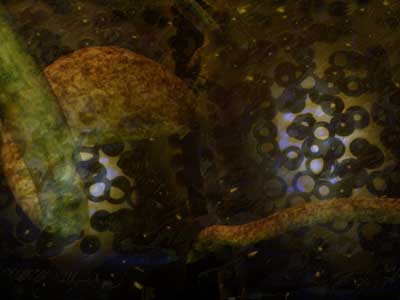 |
|
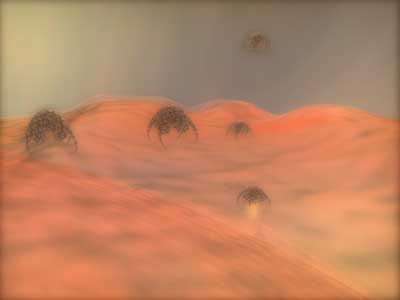 |
|
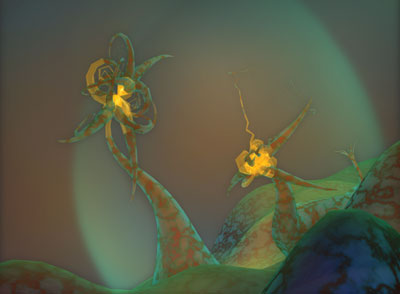 |
|
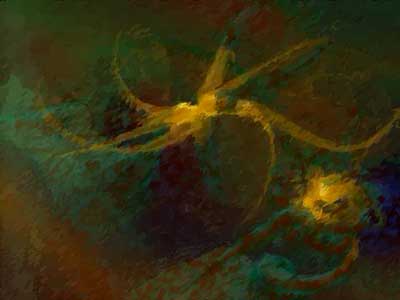 |
|
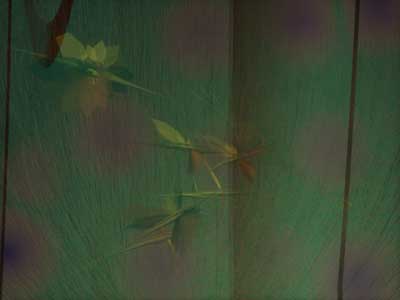 |
|
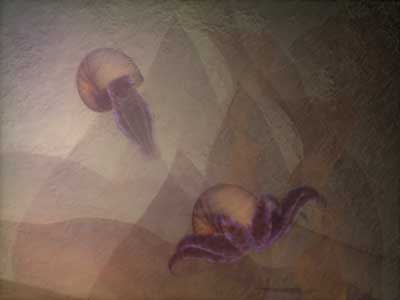 |
Motion Studies:
Nautilus by Sherri Schmitz : Quicktime ~445Kb (postprossesing by Jon Woodring)
Quicktime1 (~670KB) 2(~6.5MB) 3(~870KB)
Jon's postprossesing work on Movie 1
PPS Yes, one day I will redesign this page, oh, gosh, the WHOLE SITE to look pretty...